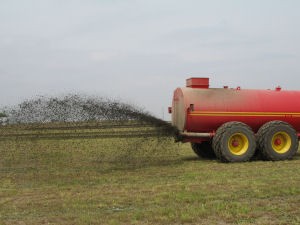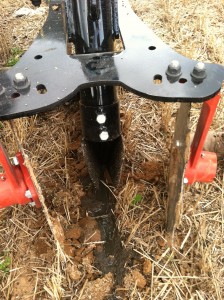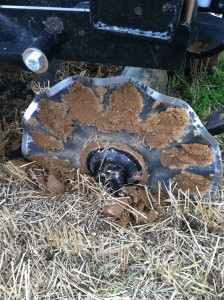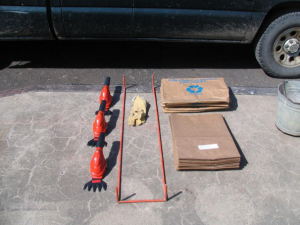The use of manure as an organic fertilizer is a critical component of dairy cropping systems. It essentially allows the farmer to find a cheap, productive use of manure while supplying crops in the field with necessary nutrients.
There are many different methods for applying manure. Broadcasting is the most commonly used method of manure application since it is typically fast and cheap. However, you get what you pay for. When the ammonia (NH3) lays on the surface of the soil, you will experience losses in nitrogen due to volatilization, leaving much less nitrogen behind than the initial amount available. Another issue with broadcasting is uniformity. Since the actual distribution of the manure varies with broadcasting, uniformity of application leaves some areas of the field with more/less manure than other. Furthermore, if you live relatively close to “city folk” and plan to broadcast manure, you will receive many complaints about the foul odor from your fields.
The only way to reduce losses and limit odor would be to make another pass through the field and incorporate (disk the manure into the field), and attempting to increase uniformity with broadcast would only create more variability in abundance of ammonia. However, more passes through the field mean more soil compaction, more fuel and more soil disturbance.
Manure injection is another method in applying manure to fields. With injection, multiple hoses feed from the tank. Disks are used to create slits in the soil large enough to allow manure, which feeds through a series of hoses and exits out of the end from the boot, to enter the first few inches of the soil. Immediately after manure is injected into the soil, another set of disks recovers the manure with the disturbed soil surrounding the slits.
On the other hand with manure injection, the ammonia is buried beneath the soil, eliminating major losses due to volatilization. With more ammonia preserved in the soil over the course of the growing season, the need for side dressing later in the season can be eliminated, saving farmers thousands of dollars. In addition, the manure is covered underneath the soil, drastically reducing odor in the field. Another benefit of injection includes uniformity of application. With uniform application, nutrients are dispersed evenly, and with this, the likelihood of excess or deficient amount of nutrients will be much less prevalent throughout the field. However, injection requires experience, so the process of applying manure will become faster and more efficient over time.
Here at NMSP, I am partaking in a project to determine the impact of manure injection on grass and alfalfa yield and quality, stand health, environmental indicators (soil nitrate, phosphorus and potassium) and greenhouse gas emissions.
For our manure injection research, we used four different fields (Fields 33 and 47 near the Cornell University Ruminant Center and Field Z Grass and Alfalfa at the Musgrave Research Farm). The fields at CURC each contained six replications (rep), and each rep contained four plots. The alfalfa field at Musgrave contained 12 reps and the grass field contained six reps. Four treatments were used in our study: broadcasting, injection with manure, injection with no manure, and no injection and no manure (control). Each plot in every replication represented one of four the treatments. We used, in collaboration with Scott Potter, a Veenhuis manure injector model for our trial.
No manure was applied to the fields before the first cut of grass and alfalfa. When the time was right to harvest the alfalfa, we cut samples from the fields with clippers that resemble hand sheers used in sheering sheep. We determined the yield per acre from the three quadrats (frames with a 3’ x 1’ dimension) of samples from each plot once they were dried in the Caldwell ovens for least four days at 60 degrees Celsius. Once weighed, the samples were grounded so they could be sent to and analyzed in the lab. Once the first cut was harvested, we readied for manure application.
As for our second cut, we repeated the same procedure for hand harvesting with no further manure application for the rest of this year’s trial, and we are hoping to get our third cut in soon. We are still looking over and collecting data, so there are no inconclusive results from our study yet.







